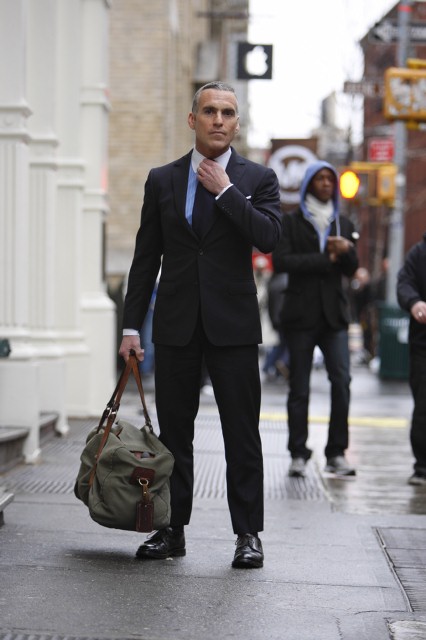
When I connected with Design Star castoff Tom Vecchione yesterday afternoon, I loved him immediately. What a great laugh! What interesting insight! He’s knowledgeable and articulate without coming off as snotty or above anyone. His quiet confidence stands in sharp contrast to fellow competitors who feel like they have to beat you over the head with their supposed greatness…and I’m not just referring to this season. There’s at least one designer every cycle whose ego surpasses evidence of their talent.
First of all, I did a lot of research before the season aired and I didn’t really find a lot of stuff on you until late last night. I didn’t realize you were such a god of the design world!
If you could see me, I’d be a red face with a big smile, laughing. That’s an interesting way of putting it—I wish the judges saw it that way! Thank you for the compliment. I’ve been doing this for a long time and my heart’s really in it.
You don’t strike me as being the type of guy who spends a lot of time watching TV. Did you see the show before?
I did see the show before—once. I’ll be honest. I travel a lot for work and I’ve spent the last umpteen years growing this company and really focusing on taking it global. I do a lot of corporate, big-scale projects. I don’t have a lot of time to sit and watch TV so I didn’t know the show that well, but I knew it had a great reputation. I knew people were really excited by it and I thought it would be really fun to dive into this other kind of arena that I haven’t been in and just kind of test my mettle. I’ll have fun with it and see where it takes me. It was thrilling–absolutely thrilling. It was like going to design camp! How could anyone give up this unbelievable opportunity to go to design camp? Nobody ever said it was going to be the Survivor of design camp!
Your attire caught a lot of attention. Did you ruin any of your fabulous suits during the making of Design Star?
I really didn’t ruin anything. I’m sort of European this way, but I have no problem if there’s a stain or a little paint on a suit. If it’s good, it wears in–not out! I don’t mind if you see a little paint spot. I have something to talk about when I walk into a client meeting. If they see a beautiful Zegna suit and say, “What’s that little red thing?” I say, “That was the time I was on Design Star!” It’s a great storytelling technique, to have your $2,000 suit splattered with paint! When I was getting involved with the show, I said, “I’ve just gotta be who I am. I’m just going to be the person I am every day.” That’s really who I am. There really wasn’t that much damage though.
Well, you’re a better painter than I am then! But…speaking of paint…
Oh, no!
There are a bazillion shades of blue in denim. What made you pick the shade you selected for the bathroom?
I love spas. I love feeling like you’re going into a cave. I love that grotto effect—that dark, rich feeling. I love blue. Obviously, if you take a look at my wardrobe, I have a range from blue to dark gray. That’s my palette. I’d just recently been staying at the Observatory Hotel while I was working in Australia and they had this wonderful pool. The pool was in a sunken grotto. The ceiling was this cobalt—that really, really dark blue. It had all these stars in the ceiling. I would swim every morning before going to work and it just really had these strong memories for me. So when I was thinking about luxury and the Trump brand—and there was this kind of rich blue in the lobby, I noticed too—I tried to interpret that upstairs in the bathroom. I was trying to get that sense that you’re in the grotto–you’re cool, you’re in the spa. It connoted luxury for me. I think in the end, it really didn’t have that “wow” effect I wanted. I opened up that can of paint and was like, “Okay, it’s not quite there, but I’m gonna go for it.”
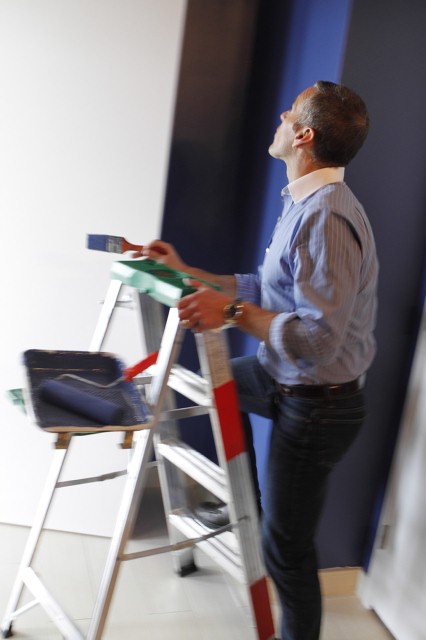
The infamous "blueberry" bathroom.
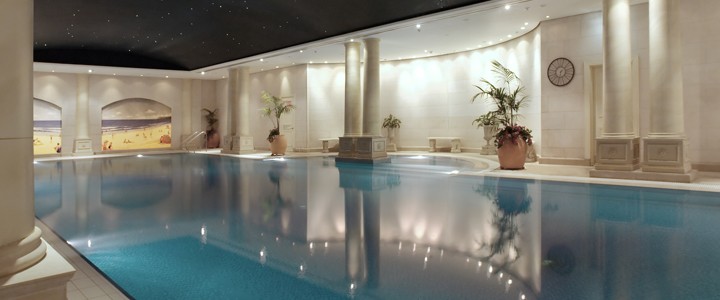
The Observatory Hotel's pool inspired Tom's grotto-style bathroom. Photo courtesy of The Observatory Hotel, Sydney.
And the firehouse ceiling?
You can see I’m a little fixated with ceilings, right? I love architecture. I’m really an architect’s architect. I love history and I love preservation. That’s why–in the Trump apartment—I looked at that room architecturally as a whole. I painted the ceiling the same color as the walls because I wanted it to have the architectural sense of a cave or a grotto. When I was in the firehouse, I’m thinking it’s one of those spectacular buildings, built in 1880. When I was taking down the ceiling—one of those ceiling tiles actually fell on my head and cut my forehead—I looked up and I was like, “Wow!” It was like being an archaeologist. I got so excited as I started peeling down the ceiling. Part of the problem was, it was really blemished and it was in sad shape. A lot of times what we do with a high ceiling is you paint it dark to have the blemishes fade out. It becomes more of a sort of feeling of height, like in a movie theater with a dark ceiling. If you paint it white or a lighter color, you would see all those blemishes pop. I chose to do the black, I chose to let it fade back. I think the correlation between soot and fire and black probably was the big thing against that. I thought the concept was strong. Maybe in another situation it would probably have been more appropriate.
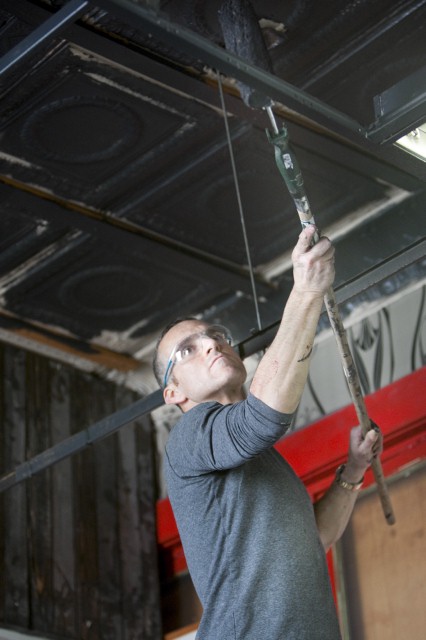
Have you ever seen a more impeccably-dressed painter? Tom gives the firehouse ceiling a coat of sooty black paint.
What did you think of the judges’ fashion sense?
Am I judging the judges?
Yes!
Ohhh—now this is the kind of conversation I like! I think Genevieve (Gorder) is very sophisticated. She had a really casual but elegant style. I think Candice (Olson) is a little brassier, but in a good way. She has that little bit of sparkle, so some of her outfits were a little more edgy and sort of push it. They go with her height and create a brighter and more powerful look and I thought that worked well. Vern (Yip)? I wasn’t really sure of his sense of fashion. He never buttons his top button—that always drove me crazy! His tie’s always skewed and his button’s always a little off. That kind of always annoyed me. I’m a big fan of Italian suits. I love English shirts. But the biggest thing I love is tailoring to death. I like to take every extra inch of fabric off and just have it cut to my shape. You don’t have to wear a $2,000 suit to look good. All you have to do is spend a few dollars in tailoring to make it fit you. I have a great tailor in New York who’s just two blocks away from my apartment on Madison Avenue. As soon as I buy a suit or a shirt—anything—I take it over and he cuts it to fit me immediately. It’s just invaluable. I think Vern could use a little more tailoring going on.
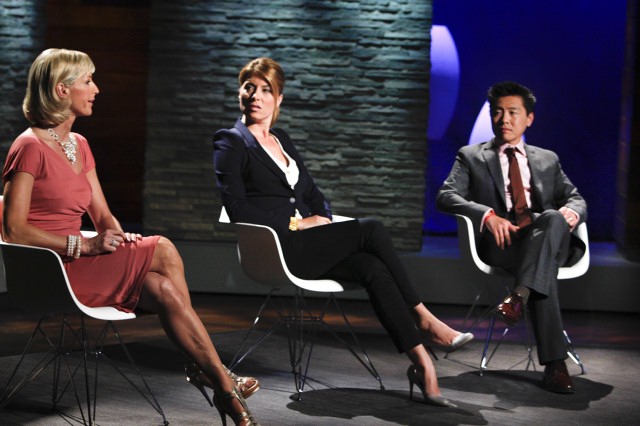
Design Star 5 judges Candice Olson, Genevieve Gorder and Vern Yip.
Jason Champion, a contestant from last season, was really bothered by Vern’s shoes.
I didn’t really notice the shoes, but I’m a big fan of reusing and adapting, so what I do is, I’ll buy a pretty good pair of shoes and then I’ll have them resoled a number of times. Once the leather soles start to go, I’ll maybe put a boot sole on a pair of dress shoes. I like to play around a little bit with shoes too. Some people make fun of my shoes! I do love fashion and I do love great suits and I really love the silhouette of a great suit. I think it’s very architectural. I think fashion and design are sort of transparent to each other. They’re a shared story together.
Have you ever considered a career as a Lamaze coach?
As a Lamaze coach? Why would you ask that question? (Laughing.) Because of my huffing and puffing? I was a gymnast in college and I kayak on the weekends and I mountain bike and I’m a swimmer—I swim every day at my club in New York. It’s a way of getting rid of my stress. I’m very passionate about working out and really getting that energy up. It was totally authentic and I didn’t realize I was doing it. When I saw those clips? You could’ve just played carnival music behind me! I was like, “So that’s what I’m like!”
How did it feel like to go from working on multi-million dollar projects to scrapping for art? That must’ve been a huge culture shock.
That’s an interesting question, because actually, in my personal life and design– like my beach house or my apartment—I love to collect things. I love to mix things up. I’m very scrappy with my personal stuff. I love a mix of art with anything from contemporary to Asian to antiques. I really like that, but it’s not what I “do.” I do big planning exercises in big cities, I build buildings and headquarters and things like that. When I heard the challenges were going to be so small, so intimate, and so fast, I said, “You know what? The point of a challenge is to challenge yourself.” I was really looking forward to—and a little nervous—jumping into all the things that I never do, that I’m probably not that good at. I don’t really do a lot of residential work. My career isn’t really based on styling or decorating or based on handyman specials. But if the true meaning of “challenge” is to do something outside of your boundaries, then I’m gonna jump right in. I loved it. Right when you’re ready to jump in into cold, cold water, you’re really nervous, but you do it and it’s exhilarating. That’s what it was like for me.
Was it difficult at all, working with and against designers with less experience–or less quality of experience–than you had?
I think that everybody brought something really unique to the table. I mentor a lot of young people at my office and I’m very involved with design education. I’m very into that. I mentor both young people and people who work with me, but I also learn from them. There’s always a mutual agenda. They have a different point of view, and diversity of thought makes everybody smarter. When I went into the competition, I thought everyone would bring something unique and special to the table and they’re gonna be damn good at that thing. That is going to be the challenge I have to overcome. It was very interesting to be challenged in different directions. It was almost like playing soccer with a basketball player. You’re both athletes but you do completely different things. It was really frustrating, but at the same time, very interesting.
What was your reaction when you heard Nina Ferrer say she was better than everyone in your group, including you?
I love confidence, I love positive energy. I work with a lot of women and I love to see women who are confident and strong. I think sometimes there’s a double standard. Sometimes people judge women harsher if they’re very confident, versus the same in a man. My sister’s a surgeon, my mother’s a teacher—I come from a background with a lot of really strong, confident women. I like that. I actually like that part of Nina’s personality. I think that’s good. I think women can be as tough as men, as strong as men, and they’re not necessarily considered a bitch because of it.
I agree with all of those things, except I find it offensive that she said she was better than you.
I guess I took everything with a grain of salt. I know the kind of pressure everyone was under. I know we’re all trying to keep our personas up there. We’re trying to be defensive and we’re trying to protect ourselves. We’re also trying to let each other in so we can work together. I took it as maybe a comment versus a philosophy. I think she had really interesting qualities that I found fascinating.
Who did you consider your biggest threat?
I think there’s “threat” and then there’s “competition” –they’re different things. I think Michael (Moeller) is an incredibly talented designer. The way his mind works and the way he juxtaposes objects—he’s really talented at creating these fantasy-type environments. When I think, “threat,” I think of someone who is out to reposition a situation for their own betterment. Courtland (Bascon) is an example. Courtland’s a great craftsman. He’s a really good painter. Michael’s a really great designer. I saw Michael as tough competition. I saw Courtland as trying to get ahead by positioning himself better than other people, just kind of putting himself in places where he was going to be seen as maybe having the upper hand. He’s a nice guy—I like him—but I think Michael’s strong competition, I think Courtland’s strategic in the way that he manipulates situations. He play-acts a lot too. He spins situations. Like the whole video at the end where he was basically criticizing poor Stacey (Cohen)’s work and curtains or making fun of my blueberry colors, but that was his whole video. He leveraged the unfortunate mistakes Stacey and I made. He didn’t make statements in praise of his own work or speaking to a philosophy of his, because he doesn’t really have one. He was more about, “Let me make fun of my two colleagues I worked on this apartment with.” I find that sort of an unattractive quality in people.
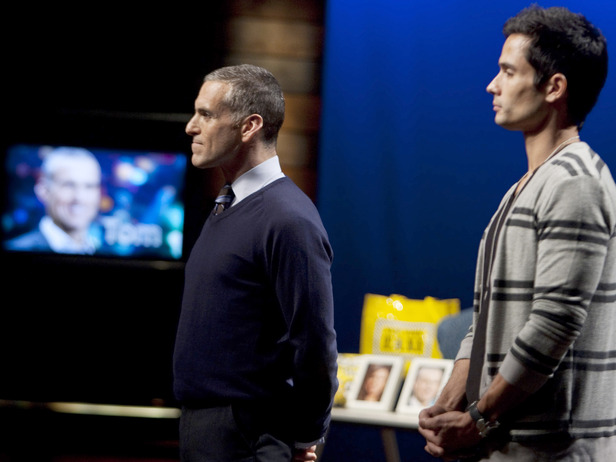
Tom and Courtland face off in the studio during the sixth episode's elimination.
Which challenge inspired you the most?
They all were really inspiring. Even though I lost, I loved the firehouse. I’m on the board of trustees for the New York City Landmarks Foundation and anytime I get to work with a great old building and kind of uncover things, find things—I get super excited about it. I’ll be honest, whether I won or lost, I got a chance to work on that building! I got a chance to see something that’s been covered up for, how many years? That was fun.
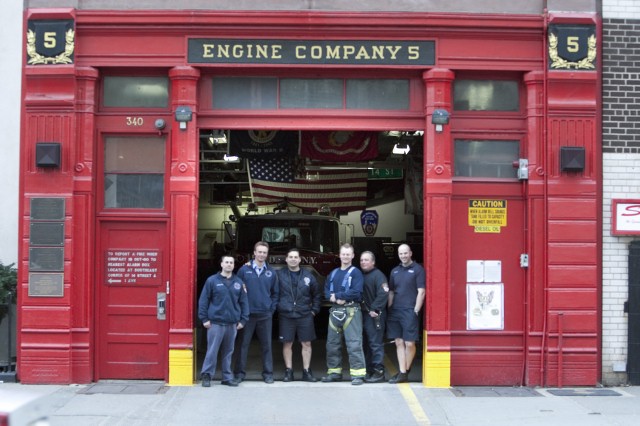
NYC's Engine Company 5, home of the Red Team's makeover project in the fifth episode.
Are you still active in the Gensler Education Initiative? (A design-related outreach program for NYC high school students.)
That was something that I actually started years ago and I’m active with it but I’ve also sort of moved on to some other things, like Landmarks Preservation. I helped set up a school downtown a few years ago that was part of the Education Initiative. It’s called the New Design High School. It’s a design-based curriculum, but it’s a public high school. All of the math, science, social studies and English curriculum is sort of based around the theme of design. It’s public school for design-oriented youth, but you don’t necessarily graduate as a designer. It’s about helping young people understand the power of design and how design thinking helps them in any world that they choose to develop their career in. I love design education. That’s why I was so excited about being on this show, to be perfectly honest with you. I felt that there was this opportunity to be part of Design Star, which tons of people watch and enjoy, and to be part of that. I believe that design thinking can help make everybody’s life better. Whether you paint the walls a beautiful color, you plan a city a certain way, you design a light switch in a certain way–life is better and easier when people design it. I love being part of that.
How has this experience affected you on the job now?
That’s a tough question to answer. I’m not really sure. It was an amazing experience internally for me. I haven’t figured out how it’s translated to me here on the job. The life that I lead and the work that I do as rich and exciting and entertaining as a TV show. They blend well together. It’s not a “before and after.” The vibrancy of going from city to city and working on interesting projects with fast deadlines and opening a school downtown…I met with Prince Charles because I’m on the sustainable committee. There’s all these things that are happening because my life is sort of fluid. It’s not like there’s a separation of church and state—it’s not like that. My work and personal life are kind of one thing. So the show, in a crazy way, doesn’t seem that off-beat for me.
Tom Vecchione continues to perform his globe-trotting corporate design magic for Gensler. There’s a wealth of impressive information about him on the Internets–if this interview spurs your curiousity about him, I highly recommend checking out these articles:
“Tom Vecchione – Fast 50 2002.” Fast Company, February 28, 2002
“Gensler’s Tom Vecchione,” by Katy Donogue. Whitewall: Contemporary Art and Lifestyle Magazine, June 23, 2009.
“Cinematic Thrill New Office Modern Design.” Exinterior Design, June 14, 2010.
“Tom Vecchione.” OnOffice, July 26, 2010.
Gensler website and online portfolio
Coming up tomorrow: my interview with castoff Stacey Cohen!
Unless otherwise noted, all photos courtesy of HGTV.

Love, love, love this interview! I never thought Tom was a bad designer, I just thought the show wasn’t a good environment for him. I liked Tom a lot, and think he got a bad rap. I am so happy for this interview because it’s such a great account of who Tom really is as a PERSON, which helps to define him as a designer. I’m totally Team Tom now, and sad to see him gone.
Okay, new crush! What he said about strong women – even though I’m not a Nina fan – made me fall in love. He is such a smart and talented guy. The show has really done a disservice to the designers, and the viewers, not to showcase all these folks’ talents and personalities (and past successes). The challenges are dumb and much less interesting to watch than in seasons past and no matter how much glitz and sparkle you put on with the music and the credits and the camera angles, the audience is smart and see through the b.s. Anyway, yay Tom! It’s great to see there are really awesome successful designers out there who help people advance their careers by building them up instead of tearing them down.
Man. I think I like Tom. Sad to see him go – although I don’t really think he was a good fit for D*. Also – I wish there was a New Design High in more places than NY. It makes me want to re-do high school! Aaah!
Wow, what a fab guy! My Tom crush is officially in effect…
BRAVO, Tom! Such a classy man, a true gentleman!
I loved Tom because he always had such great energy and positivity. This interview just proves more of the same.
Amazing how the impressions formed from watching the show are consistent with the personas revealed in your interviews. Great questions and thanks for the links.